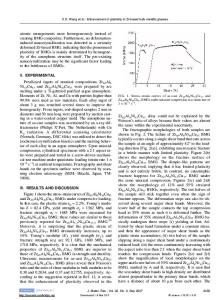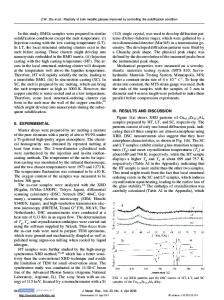Enhance plasticity of bulk metallic glasses by geometric confinement
- PDF / 253,664 Bytes
- 5 Pages / 585 x 783 pts Page_size
- 32 Downloads / 382 Views
We report that bulk metallic glasses (BMGs) with large plasticity can be obtained in conventional brittle BMGs by a shrink-fit metal sleeve. The mechanical performance especially the plasticity in the Zr41.2Ti13.8Cu12.5Ni10Be22.5 BMG with a shrink-fit copper sleeve is much enhanced. The approach results in the formation of the highly dense and frequent interacting and arresting events of shear bands and is the origin of the observed large global plasticity. The results present another simple step toward toughening the inherently brittle BMGs.
I. INTRODUCTION
The bulk metallic glasses (BMGs) have unique properties such as ultrahigh strength, lower Young’s modulus, high elastic strain limit, excellent abradability, and corrosion resistance, which lead to outstanding application potentials in place of traditional crystalline metals.1–3 However, the plasticity of BMGs at room temperature is usually disappointingly low due to the lack of dislocation systems and grain structure.4–10 Upon yielding, the plastic deformation of the BMGs is highly localized into shear bands. These shear bands can rapidly propagate across the sample after their initiation and initiate cracking and lead to macroscopic catastrophic fracture. The limited global plasticity, less than 1%, restricts the use of BMGs as engineering materials.4–10 Cumulative efforts to improve the plastic deformability of BMGs have been shown to be effective in controlling the plastic instability.11–23 A variety of BMG composites have been made by introducing the second crystalline phase or by in situ formation of crystalline phase through partial crystallization in the glassy matrix.12–15 The ultimate aim of this approach is to restrict the rapid propagation of the shear bands by interaction with the ductile crystalline phases.11–23 Recently, a few approaches have been proposed to successfully prepare the BMGs with large compressive plasticity,16–24 such as to achieve a critical value of Poisson’s ratio22,23 or to introduce atomic-scale inhomogenities10 or a phaseseparated glassy structure.24 However, the approaches are only focused on exploring new alloy systems and are not effective to the present numerous BMG systems. So,
it would be beneficial to develop simple and feasible methods that could enhance the plasticity of the BMGs including the known BMG systems. On the other hand, unlike the crystalline materials, the mechanisms of the plastic deformation are well understood by motion of dislocations; the reason causing the plasticity in BMGs is unclear, and the relevant elucidations remain controversial. The brittle materials, such as silicate glasses, are found to be sensitive to the surface structure and residual stress, which directly affect the ultimate plasticity and fracture.25 Conventional silicate glasses have even greater problems with lack of ductility. Yet the strength of the silicate glasses can be increased by tempering to induce compressive residual stress at their surface. Therefore, they are widely used as structural materials (e.g., car windscree
Data Loading...











